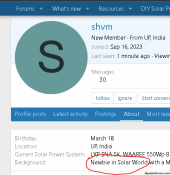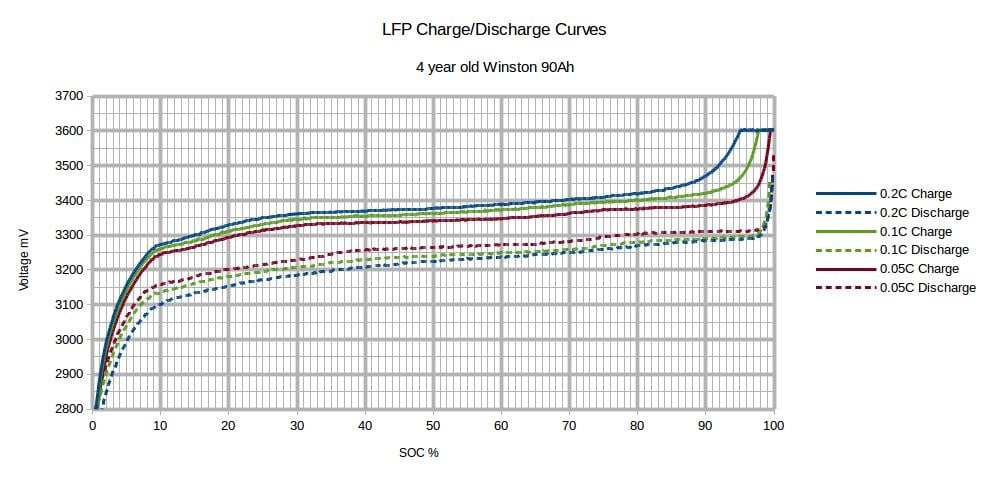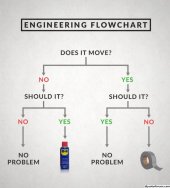Do you know that LFPs need to be balanced every few months and not at every charge cycle? OR
Are you aware that setting float voltage of your LFP battery above 3.37V/Cell is overcharging it and harming its potential lifespan and causing cell imbalance?
Chances are extremely high that you don't. The entire point of this post is to explain exactly why that is the case for LFP but is also applicable to other Li chemistries. Whenever in doubt, always consult the datasheet supplied by your Cell manufacturer.
For ease of understanding, this guide is divided into five sections:
For example, This is what the EVE 230 Ah Cell datasheet (Section 4.2) says:

Alongside CC at 0.5C and CV at 3.65V, pay careful attention to the "0.05C cut off" part.
0.05 C for 230Ah LFP cell is equal to 230 × 0.05 = 11.5 Amps.
It means that charging must be strictly terminated/stopped once the charging current falls to 11.5 Amps @ 3.65 Volts and the cell is left to rest.
The Cell is rated for 0.5 C or 115 Amps max. recommended charge current. Once charging current falls to one tenth of the Cell's rated charge current 0.05 C @ 3.65V, charging should be terminated.
That is how capacity, cycle life etc. are measured by cell manufacturers in their labs.
For LFP Cells with older chemistry, you may see its datasheet recommended a value of 0.033 C as charge cut off. For calculations just remember to substitute this value instead of 0.05 C.
Balancing basically means bringing all Cells (in a battery) to same SOC. In this case, top-balancing means bringing all cells to 100% SOC. Bottom balancing means 0% SOC. It is implied at this point that all Cells that will be used in a battery are well matched. i.e., same capacity in Ah, same age (new, aged or cycled), same chemistry (manufacturer), similar in internal resistance etc.
The ideal (and most time consuming) way to do initial top-balance for a battery will always be to take each Cell, subject it to standard charge model as mentioned above and then connecting all such cells to yield a top-balanced battery. After that, the battery can be charged and discharged just like a single LFP cell with charging voltage proportional to number of cells in series and same 0.05 C cut off. All this assumes you got a charge controller capable of doing exactly that !
The second best way to top-balance is to bring cells to 100% SOC at once by charging them in parallel.
For the purpose of this section, I will assume you have four LFP Cells that can be combined in series later to give a 12.8 V battery (4S configuration).
If you have new cells straight from the factory, chances are good that they are shipped at roughly the same SOC/voltage. Then, It is possible to connect them all in parallel without much drama, (sparks flying due to Cells at different voltages trying to quickly distribute charge) !
Multiple Cells in parallel is basically a very large capacity Cell and can be then easily brought to 100% SOC using Standard charge model in Section 1 above. This is of course assuming that you have got a power supply to maintain the proportionally larger current required at cut-off.
For example, 0.05 C cut off for four EVE 230 Ah LFP Cells connected is parallel will be 4 × 0.05 × 230 = 46 Amps @ 3.65 Volts.
It basically means once current has dropped to 46 Amps @ 3.65V, charging should be stopped and cells should be assumed to be top-balanced.
What this means is we need to improvise on the standard charging model a little. And this is where things get 'somewhat' complicated and the main source of confusion lies.
And the insight into that comes from determining the fully charged resting voltage for a LFP Cell.
Let's say you take a brand new LFP Cell and charge it exactly like the Standard Charge Model says above.
Can you guess how its Voltage will change with time at rest with no current going in or out?
Naturally it can be observed that it will settle down to a voltage lower than 3.65 V. If you've got a spare Cell and lab equipment lying around, this value is easy to determine.
This 'full charge voltage' or FCV which will be obviously <3.65 is the resting voltage of a fully charged LFP Cell. Basically it represents the charging limit beyond which reversibility of LFP chemistry starts diminishing. To keep a cell topped up, standard charging model can be re-initiated once the cell has discharged somewhat and its voltage drops below FCV.
So, if you don't want to (or are not able to) cut off current as mentioned in the standard charging model in section 1, you can also (in theory) fully charge any LFP Cell by maintaining FCV across its terminals and allowing current to go zero. It will take basically forever but it should also fully charge a LFP Cell.
This is basically the same as saying cut off current is 0 C for charging at FCV for a LFP Cell.
Then it is a simple matter of applying linear regression to find the desired (voltage, current) pair connecting these two extremes. (FCV, 0 C) and (3.65 V, 0.05 C).
For example, Let's tackle the example of top-balancing 4 EVE 230 Ah Cells in parallel using a 10 Amps power supply.
The equivalent cell capacity is 230 × 4 = 920 Ah of which 10 Amps charging current constitutes ~0.011 C rate.
The charging voltage for this cut off current will obviously lie above FCV @ 0 C and at the same time below 3.65 V @ 0.05 C.
This is the proper way to determine what charging voltage to target in your DC power supply for top-balancing.
Anyone saying top-balancing of cells in parallel is done by setting DC power supply to 3.65 V beforehand and letting current drop to 0 is unaware of complete charging model for LFP.
Needless to say, the damage this 'top-balancing' and improper charging causes to the otherwise 2000+ cycle-life LFP cells remains to be investigated.
Are you aware that setting float voltage of your LFP battery above 3.37V/Cell is overcharging it and harming its potential lifespan and causing cell imbalance?
Chances are extremely high that you don't. The entire point of this post is to explain exactly why that is the case for LFP but is also applicable to other Li chemistries. Whenever in doubt, always consult the datasheet supplied by your Cell manufacturer.
For ease of understanding, this guide is divided into five sections:
- Correct/Standard charge model for a LFP Cell (or Cells in parallel)
- Initial Top-Balancing of a LFP Battery (Cells in series) before commissioning
- Modified/improved charge model for a LFP Cell/Battery
- Maintaining Balance in the context of BMS settings
- Approaching proper LFP charging with Lead-Acid chargers
1. Correct/Standard charge model for a LFP Cell
One can consult any reputable LFP cell manufacturer datasheet, including but not limited to CALB, EVE etc. The proper and correct charging model for a modern LFP Cell is identical everywhere.For example, This is what the EVE 230 Ah Cell datasheet (Section 4.2) says:

Alongside CC at 0.5C and CV at 3.65V, pay careful attention to the "0.05C cut off" part.
0.05 C for 230Ah LFP cell is equal to 230 × 0.05 = 11.5 Amps.
It means that charging must be strictly terminated/stopped once the charging current falls to 11.5 Amps @ 3.65 Volts and the cell is left to rest.
The Cell is rated for 0.5 C or 115 Amps max. recommended charge current. Once charging current falls to one tenth of the Cell's rated charge current 0.05 C @ 3.65V, charging should be terminated.
That is how capacity, cycle life etc. are measured by cell manufacturers in their labs.
For LFP Cells with older chemistry, you may see its datasheet recommended a value of 0.033 C as charge cut off. For calculations just remember to substitute this value instead of 0.05 C.
2. Initial Top-Balancing of a LFP battery
Combining multiple Cells in series is required to achieve voltages higher than 3.2V.Balancing basically means bringing all Cells (in a battery) to same SOC. In this case, top-balancing means bringing all cells to 100% SOC. Bottom balancing means 0% SOC. It is implied at this point that all Cells that will be used in a battery are well matched. i.e., same capacity in Ah, same age (new, aged or cycled), same chemistry (manufacturer), similar in internal resistance etc.
The ideal (and most time consuming) way to do initial top-balance for a battery will always be to take each Cell, subject it to standard charge model as mentioned above and then connecting all such cells to yield a top-balanced battery. After that, the battery can be charged and discharged just like a single LFP cell with charging voltage proportional to number of cells in series and same 0.05 C cut off. All this assumes you got a charge controller capable of doing exactly that !
The second best way to top-balance is to bring cells to 100% SOC at once by charging them in parallel.
For the purpose of this section, I will assume you have four LFP Cells that can be combined in series later to give a 12.8 V battery (4S configuration).
If you have new cells straight from the factory, chances are good that they are shipped at roughly the same SOC/voltage. Then, It is possible to connect them all in parallel without much drama, (sparks flying due to Cells at different voltages trying to quickly distribute charge) !
Multiple Cells in parallel is basically a very large capacity Cell and can be then easily brought to 100% SOC using Standard charge model in Section 1 above. This is of course assuming that you have got a power supply to maintain the proportionally larger current required at cut-off.
For example, 0.05 C cut off for four EVE 230 Ah LFP Cells connected is parallel will be 4 × 0.05 × 230 = 46 Amps @ 3.65 Volts.
It basically means once current has dropped to 46 Amps @ 3.65V, charging should be stopped and cells should be assumed to be top-balanced.
3. Modified/improved charging model for a LFP Cell/Battery
In section 2 where we were top-balancing 4 EVE 230 Ah Cells, it is obvious that pushing 46 Amps @ 3.65 V according to standard charge model is beyond spec of commonly available benchtop DC power supplies. Most of them are rated for 5/10 Amps max.What this means is we need to improvise on the standard charging model a little. And this is where things get 'somewhat' complicated and the main source of confusion lies.
And the insight into that comes from determining the fully charged resting voltage for a LFP Cell.
Let's say you take a brand new LFP Cell and charge it exactly like the Standard Charge Model says above.
Can you guess how its Voltage will change with time at rest with no current going in or out?
Naturally it can be observed that it will settle down to a voltage lower than 3.65 V. If you've got a spare Cell and lab equipment lying around, this value is easy to determine.
This 'full charge voltage' or FCV which will be obviously <3.65 is the resting voltage of a fully charged LFP Cell. Basically it represents the charging limit beyond which reversibility of LFP chemistry starts diminishing. To keep a cell topped up, standard charging model can be re-initiated once the cell has discharged somewhat and its voltage drops below FCV.
So, if you don't want to (or are not able to) cut off current as mentioned in the standard charging model in section 1, you can also (in theory) fully charge any LFP Cell by maintaining FCV across its terminals and allowing current to go zero. It will take basically forever but it should also fully charge a LFP Cell.
This is basically the same as saying cut off current is 0 C for charging at FCV for a LFP Cell.
Then it is a simple matter of applying linear regression to find the desired (voltage, current) pair connecting these two extremes. (FCV, 0 C) and (3.65 V, 0.05 C).
For example, Let's tackle the example of top-balancing 4 EVE 230 Ah Cells in parallel using a 10 Amps power supply.
The equivalent cell capacity is 230 × 4 = 920 Ah of which 10 Amps charging current constitutes ~0.011 C rate.
The charging voltage for this cut off current will obviously lie above FCV @ 0 C and at the same time below 3.65 V @ 0.05 C.
This is the proper way to determine what charging voltage to target in your DC power supply for top-balancing.
Anyone saying top-balancing of cells in parallel is done by setting DC power supply to 3.65 V beforehand and letting current drop to 0 is unaware of complete charging model for LFP.
Needless to say, the damage this 'top-balancing' and improper charging causes to the otherwise 2000+ cycle-life LFP cells remains to be investigated.
The second part of this guide will cover maintaining top-balance in the context of BMS settings, good LFP charging parameters and how to closely emulate it using Lead Acid charging parameters.
Last edited:






